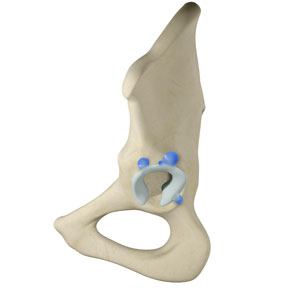
What are Labral Cysts of the Hip?
Labral cysts are small and well-defined fluid-filled sacs or lesions found adjacent to the cartilage labrum, a rim of tissue that surrounds the acetabulum (hip socket) and seals the hip joint. They are closely associated with acetabular labral tears and are more common in individuals involved in sporting activities. Labral cysts can be asymptomatic in as many as one-fourth of the individuals who have them. They are usually noted in 50 to 70 percent of individuals who have sustained labral tears.
Causes of Labral Cysts of the Hip
Labral cysts most commonly occur due to rupture of the labrum or injury to the labrum, which may occur as a result of:
- Traumatic injury, such as a motor vehicle accident
- Weight-bearing activities over time, which can lead to joint wear and tear
- Degenerative changes to the hip joint in the elderly
- Repetitive movements
When there is a rupture of the labrum in the hip, the loss of stability between the acetabulum and the femoral head can cause synovial fluid, a thick viscous liquid located between your joints, to enter the acetabular space, resulting in the formation of labral cysts.
Signs and Symptoms of Labral Cysts of the Hip
Patients with labral cysts of the hip usually have the following signs and symptoms:
- Popping, clicking, or snapping of the hip
- Anterior hip pain
- A sharp and sudden pain
- Painful bending of the hip
- Rotatory movement restriction
Diagnosis of Labral Cysts of the Hip
Labral cysts of the hip are diagnosed based on a review of your medical history, a thorough examination of hip motion and gait/walking pattern, and diagnostic studies, such as X-rays, MRI scans, and CT scans to check for any anatomical or soft-tissue abnormalities and confirm the presence of labral cysts.
Treatment of Labral Cysts of the Hip
Initial treatment for labral cysts of the hip may involve a procedure called a fine needle aspiration in which a thin needle is inserted into the cyst under ultrasound or fluoroscopic guidance to aspirate the fluid and drain the cyst. However, aspirated cysts may recur sometimes. Under such circumstances, your surgeon may opt for surgical excision of the cyst with an arthroscopic labral repair as a definitive treatment. During this procedure, the cyst is decompressed arthroscopically (complete removal of the cyst) and is followed by debridement (removal of the damaged labrum) of the degenerative labral tissues utilizing an arthroscopic thermal probe and a shaver as an effective surgical technique of management.
Surgery is immediately followed by rehabilitation and involves a focused physical therapy program to improve range of motion and strengthen hip muscles.




